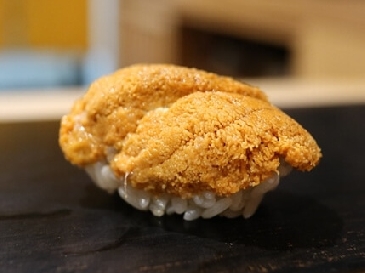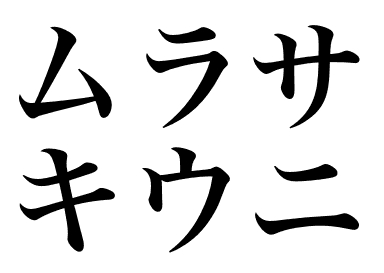Fish roe


Purple sea urchin (Murasaki uni)
【Nigiri sushi: Gyoran】
What is Murasaki uni?
Murasaki uni is distributed along the coasts of Honshu and Kyushu, with its northern limit on the Pacific Ocean side near Oarai, Ibaraki Prefecture, and its northern limit on the Sea of Japan side near Fukaura, Aomori Prefecture.
It is the most common sea urchin found along the shores of Japan. Its spines are thick, sharp, and dark purple. The shell is also thick and about 6 cm in diameter. Murasaki uni (Purple sea urchin) is distributed mainly in the warmer waters on the Pacific side of Japan. The spawning season is from May to August.
Coldwater Ezobafun uni and Kitamurasaki uni account for 3/4 of Japan's sea urchin catch. 70% of the remaining 1/4 are Murasaki uni, 25% are Bafun uni, and the rest are Aka uni and Shirahige uni, among others. Murasaki uni is often consumed locally and is rare to find at Tokyo sushi restaurants.
What dose Murasaki uni (Purple sea urchin) nigiri sushi taste like?
Sea urchin with fine texture and ocean flavor is meltingly delicious. Creamy and sweet after taste. Unlike salmon roe, the seaweed flavor loses a bit of the delicate sweetness so there are some sushi chefs who rarely make sea urchin in a roll. It is served with a splash of Nikiri and wasabi on top.
What is the difference between Northern sea urchin and Purple sea urchin?
Purple sea urchin (Murasaki uni) and Northern sea urchin (Kitamurasaki uni) are very similar, but Northern sea urchins (Murasaki uni) are a size larger than their Purple counterparts. Purple sea urchins are about 6cm in diameter and Northern sea urchins are around 10cm in diameter. Purple sea urchin habitats are generally found in warmer ocean areas such as Kyushu or China regions while the Northern sea urchins are found in colder waters around Hokkaido and Tohoku areas. The purple-colored sea urchins commonly found at markets are generally Northern sea urchins.
Also called Hard-spined sea urchin.
【Trivia】
・The umami flavor of sea urchin is mainly made up of amino acids and nucleic acids. Some of the amino acids found in this topping are glycine, alanine, valine and glutamine. The sweetness of sea urchin is related to the glycine and alanine content, while its richness comes from glutamine. It doesn’t have a high inosinic acid content, which is a nucleic acid, but the synergistic effects of the inosinic acid and glutamic acid bring out the umami flavor. It also contains methionine, an amino acid, which contributes greatly to the unique flavor that sea urchin is known for.
・In Shimonoseki city, Yamaguchi prefecture, there is an experiment that feeding sea urchin waste vegetables donated by local agricultural corporative. The experiment result of 2018 shows that the sea urchin fed tomato was the tastiest.
【Related contents 】
What is uni sushi?
Why is it that sea urchin sushi can taste bitter?
List of Nimono, Gyoran and Others
(Revision date: December 29, 2023)
Main production area
Hokkaido Aomori Toyama
Season
Summer

